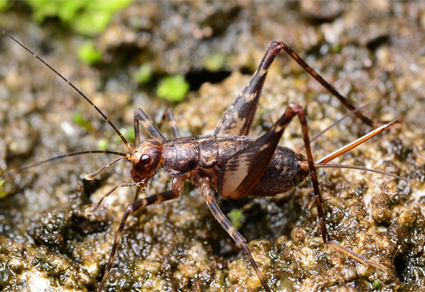Abstract
This study documents significant distributional expansions of three orthopteran taxa in China and describes a new species from the Tibetan Plateau. We present the first confirmed records of the subfamily Phalangopsinae, genus Indozacla Gorochov 2018, and species Meloimorpha cincticornis Walker 1870 in China. This newly discovered Indozacla dorsiglaber Ma & Wang sp. nov. exhibits wing sexual dimorphism, with males having short wings and females wingless. Comprehensive morphological descriptions, diagnostic comparisons, and ecological photographs are provided, supplemented by COX1 molecular data exploring the systematic relationships of several species. These findings extend the known northern limits of Phalangopsinae in Asia and contribute to understanding Himalayan orthopteran diversity.
References
- Bhowmik, H.K. (1985) Contribution to the gryllid fauna of the Western Himalayas (Orthoptera: Gryllidae). Records of the Zoological Survey of India, Miscellaneous Publication, Occasional Paper No. 73. Zoological Survey of India, Calcutta, 85 pp.
- Brunner von Wattenwyl, C. (1873) Système des Gryllides. Mitteilungen der Schweizerischen Entomologischen Gesellschaft, 4 (4), 163–170.
- Chopard, L. (1933) Sur quelques types de Gryllides (Orth.) de Fr. Walker. Bulletin de la Société Entomologique de France, 38 (11), 169–171. https://doi.org/10.3406/bsef.1933.14585
- Cigliano, M.M., Braun, H., Eades, D.C. & Otte, D. (2025) Orthoptera Species File. SpeciesFile.org, Version 5.0/5.0. Available from: http://orthoptera.speciesfile.org (accessed 6 February 2025)
- Desutter-Grandcolas, L. & Jaiswara, R. (2012) Phalangopsidae crickets from the Indian Region (Orthoptera, Grylloidea), with the descriptions of new taxa, diagnoses for genera, and a key to Indian genera. Zootaxa, 3444 (1), 1–39. https://doi.org/10.11646/zootaxa.3444.1.1
- Gorochov, A.V. (1985) On the Orthoptera subfamilies Itarinae, Podoscirtinae and Nemobiinae (Gryllidae) from eastern Indochina. In: Medvedev, L.N. (Ed.), Fauna i ekologiya nasekomykh Vetnama, 1985, pp. 17–25.
- Gorochov, A.V. (1986) System and morphological evolution of crickets from the family Gryllidae (Orthoptera) with description of new taxa. Communication 2. Zoologicheskiy Zhurnal, 65 (6), 851–858.
- Gorochov, A.V. (2003) New and little-known Cachoplistinae and Phaloriinae (Orthoptera: Gryllidae). Zoosystematica Rossica, 12 (1), 79–92. https://doi.org/10.31610/zsr/2003.12.1.79
- Gorochov, A.V. (2018) New or little-known crickets of the subfamily Phalangopsinae (Orthoptera, Gryllidae): 12. The genus Parendacustes (Part 3) and other taxa. Entomological Review, 98 (2), 170–183. https://doi.org/10.1134/S0013873818020069
- Gu, J., Dai, L. & Huang, J. (2018) Crickets (Orthoptera: Grylloidea) from Hunan Province, China. Far Eastern Entomologist, 373, 8–18. https://doi.org/10.25221/fee.373.2
- Haan, W. (1844) Bijdragen tot de kennis der Orthoptera. In: Temminck (Ed.), Verhandelingen over de Natuurlijke Geschiedenis der Nederlansche Overzeesche Bezittingen, 24, pp. 229–248.
- Ma, L.B. & Jing, X. (2018) Revision of the Phaloriini crickets (Orthoptera: Phalangopsidae: Phaloriinae) from China. The Canadian Entomologist, 150 (5), 1–16. https://doi.org/10.4039/tce.2018.40
- Ma, L.B. & Ma, G. (2019) The second species of the genus Gorochovius Xie, Zheng & Li, 2004 (Orthoptera: Phalangopsidae: Phaloriinae) discovered from China. Zootaxa, 4671 (2), 259–266. https://doi.org/10.11646/zootaxa.4671.2.6
- Nguyen, L.T., Schmidt, H.A., von Haeseler, A. & Minh, B.Q. (2015) IQ-TREE: a fast and effective stochastic algorithm for estimating maximum-likelihood phylogenies. Molecular Biology and Evolution, 32 (1), 268–274. https://doi.org/10.1093/molbev/msu300
- Saussure, H. (1877) Mélanges orthoptérologiques V. fascicule Gryllides. Mémoires de la Société de Physique et d'Histoire Naturelle de Genève, 25 (1), 169–504. https://doi.org/10.5962/bhl.title.8541
- Stål, C. (1877) Orthoptera nova ex Insulis Philippinis descripsit. Öfversigt af Kongliga Vetenskaps-Akademiens Förhandlinger, 34 (10), 33–58.
- Vasanth, M. (1993) Studies on crickets (Insecta: Orthoptera: Gryllidae) of northeast India. Records of the Zoological Survey of India, Miscellaneous Publication, Occasional Paper No. 132 (1–6). Zoological Survey of India, Calcutta, 178 pp.
- Walker, F. (1870) Catalogue of the Specimens of Dermaptera Saltatoria in the Collection of the British Museum. Vol. 3. Printed for the Trustees of the British Museum, London, pp. 425–604.
- Xie, L.D., Zheng, Z.M. & Li, W. (2004) A new genus and species of the subfamily Phaloriinae from China (Orthoptera: Eneopteridae). Acta Zootaxonomica Sinica, 29 (4), 721–724.
- Meng, G., Li, Y., Yang, C. & Liu, S. (2019) MitoZ: a toolkit for animal mitochondrial genome assembly, annotation and visualization. Nucleic Acids Research, 47 (11), e63. https://doi.org/10.1093/nar/gkz173
- Nguyen, L.T., Schmidt, H.A., von Haeseler, A. & Minh, B.Q. (2015) IQ-TREE: a fast and effective stochastic algorithm for estimating maximum-likelihood phylogenies. Molecular Biology and Evolution, 32 (1), 268–274. https://doi.org/10.1093/molbev/msu300
- Ronquist, F. & Huelsenbeck, J.P. (2003) MrBayes 3: Bayesian phylogenetic inference under mixed models. Bioinformatics, 19 (12), 1572–1574. https://doi.org/10.1093/bioinformatics/btg180
- Ronquist, F., Teslenko, M., van der Mark, P., Ayres, D.L., Darling, A., Höhna, S., Larget, B., Liu, L., Suchard, M.A. & Huelsenbeck, J.P. (2012) MrBayes 3.2: efficient Bayesian phylogenetic inference and model choice across a large model space. Systematic biology, 61 (3), 539–542. https://doi.org/10.1093/sysbio/sys029
- Talavera, G. & Castresana, J. (2007) Improvement of phylogenies after removing divergent and ambiguously aligned blocks from protein sequence alignments. Systematic biology, 56 (4), 564–577. https://doi.org/10.1080/10635150701472164
- Zhang, D., Gao, F., Li, W., Jakovlić, I., Zou, H., Zhang, J., Li, W.X. & Wang, G.T. (2020) PhyloSuite: an integrated and scalable desktop platform for streamlined molecular sequence data management and evolutionary phylogenetics studies. Molecular Ecology Resources, 20 (1), 348–355. https://doi.org/10.1101/489088


